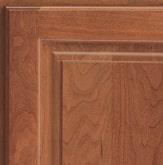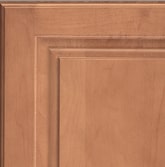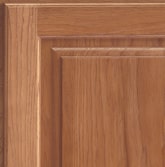There’s a reason why people love cabinets made from Cherry. Or Alder. Or Oak. Each wood has natural color variations and grain patterns that create a unique look.
Which wood look do you like best?
Choosing a type of wood goes hand-in-hand with choosing a stain or translucent finish. Each has characteristics that those finish options will accentuate (or disguise). Just look how different our Ginger finish looks on each wood:

Alder
Ranges from pale pink-brown to tan
Features knotholes, burls and mineral streaks
Commonly used for a rustic or industrial look

Cherry
Reddish-brown hues that mellow (darken) over time
Smooth, straight-grain pattern
Cherry wood features light and dark color variation which becomes more pronounced as it ages.

Maple
Off-white with light, creamy hues of gold
Consistent, fine grain with occasional mineral streaks
Maple is typically used with paints because of it’s smooth uniformity

Hickory
Dramatic color contrasts from light cream to dark reddish-brown
Random grain pattern with burls and knots

Oak
Light to medium brown
Richly-textured, wavy grain pattern
Remember, wood is a natural material.

1. Joint Lines
Since wood is in a constant state of expansion and contraction, visible surface cracks at joints may appear in the finish. This is normal and will not weaken the strength of the joint or the integrity of the finish.
2. End Grain
You may notice a darker appearance to cabinet doors where end grain is exposed. End grain is a softer surface that may accept more stain than the facing surface. Variances are not controllable.
3. Aging
As wood ages, the appearance may change or darken. For example, a lightly-stained Cherry will “mellow” adding depth over time. This is often considered a desirable characteristic.
4. Telegraphing
Wood grain, pin holes, knots and mineral streaks may remain visible as a dark area or texture under painted finishes. Open-grain woods (oak, hickory) tend to show more than fine-grained species (maple, cherry).
5. Mineral Streaks
Wood may feature dark, blackish-blue streaks that run parallel with the wood grain. These discolorations come from mineral deposits trees extract from the surrounding soil.
Make it yours.
Give your kitchen the look you’re dreaming of with our collection of finish options.
Paints. Stains. Unique specialty finishes. Find your favorite.
Unsure which wood and finish combination fits your style? Drop us a line.
Make it yours.
Give your kitchen the look you’re dreaming of with our collection of finish options.
Paints. Stains. Unique specialty finishes. Find your favorite.
Unsure which wood and finish combination fits your style? Drop us a line.
